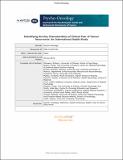Files in this item
Identifying the key characteristics of clinical fear of cancer recurrence : an international Delphi study
Item metadata
| dc.contributor.author | Mutsaers, Brittany | |
| dc.contributor.author | Butow, Phyllis | |
| dc.contributor.author | Dinkel, Andreas | |
| dc.contributor.author | Humphris, Gerald Michael | |
| dc.contributor.author | Maheu, Christine | |
| dc.contributor.author | Ozakinci, Gozde | |
| dc.contributor.author | Prins, Judith | |
| dc.contributor.author | Sharpe, Louise | |
| dc.contributor.author | Smith, Allen "Ben" | |
| dc.contributor.author | Lebel, Sophie | |
| dc.date.accessioned | 2020-12-07T15:54:45Z | |
| dc.date.available | 2020-12-07T15:54:45Z | |
| dc.date.issued | 2019-11-25 | |
| dc.identifier | 262736040 | |
| dc.identifier | 2584454b-35b3-4b1d-bc93-08188cc5f127 | |
| dc.identifier | 85076235078 | |
| dc.identifier | 000498406600001 | |
| dc.identifier.citation | Mutsaers , B , Butow , P , Dinkel , A , Humphris , G M , Maheu , C , Ozakinci , G , Prins , J , Sharpe , L , Smith , A & Lebel , S 2019 , ' Identifying the key characteristics of clinical fear of cancer recurrence : an international Delphi study ' , Psycho-Oncology , vol. Early View . https://doi.org/10.1002/pon.5283 | en |
| dc.identifier.issn | 1057-9249 | |
| dc.identifier.other | ORCID: /0000-0002-4601-8834/work/65345290 | |
| dc.identifier.other | ORCID: /0000-0001-5869-3274/work/65345296 | |
| dc.identifier.uri | https://hdl.handle.net/10023/21072 | |
| dc.description.abstract | Objective: Without an agreed‐upon set of characteristics that differentiate clinical from non‐clinical levels of fear of cancer recurrence (FCR), it is difficult to ensure that FCR severity is appropriately measured, and that those in need of intervention are identified. The objective of this study was to establish expert consensus on the defining features of clinical FCR. Method: A three‐round Delphi was used to reach consensus on the defining features of clinical FCR. Sixty‐five experts in FCR (researchers, psychologists, physicians, nurses, allied health professionals) were recruited to suggest and rate potential features of clinical FCR. Participants who indicated they could communicate diagnoses within their clinical role were also asked to consider the application of established DSM‐5 and proposed ICD‐11 diagnostic criteria (Health Anxiety, Illness Anxiety Disorder, Somatic Symptom Disorder) to clinical FCR. Results: Participants’ ratings suggested that the following 4 features are key characteristics of clinical FCR: 1) high levels of preoccupation; 2) high levels of worry; 3) that are persistent; and 4) hypervigilance to bodily symptoms. Of participants whose professional role allowed them to diagnose mental disorders 84% indicated it would be helpful to diagnose clinical FCR, but the use of established diagnostic criteria related to health anxiety or somatic‐related disorders to clinical FCR was not supported. This suggests that participants consider clinical FCR as a presentation that is specific to cancer survivors. Conclusion: Clinical FCR was conceptualized as a multi‐dimensional construct. Further research is needed to empirically validate the proposed defining features. | |
| dc.format.extent | 986564 | |
| dc.language.iso | eng | |
| dc.relation.ispartof | Psycho-Oncology | en |
| dc.subject | Cancer | en |
| dc.subject | Oncology | en |
| dc.subject | Definition | en |
| dc.subject | Delphi | en |
| dc.subject | Expert consensus | en |
| dc.subject | Fear of cancer recurrrence | en |
| dc.subject | RC0254 Neoplasms. Tumors. Oncology (including Cancer) | en |
| dc.subject | RC0321 Neuroscience. Biological psychiatry. Neuropsychiatry | en |
| dc.subject | NDAS | en |
| dc.subject | SDG 3 - Good Health and Well-being | en |
| dc.subject.lcc | RC0254 | en |
| dc.subject.lcc | RC0321 | en |
| dc.title | Identifying the key characteristics of clinical fear of cancer recurrence : an international Delphi study | en |
| dc.type | Journal article | en |
| dc.contributor.institution | University of St Andrews. Sir James Mackenzie Institute for Early Diagnosis | en |
| dc.contributor.institution | University of St Andrews. Population and Behavioural Science Division | en |
| dc.contributor.institution | University of St Andrews. WHO Collaborating Centre for International Child & Adolescent Health Policy | en |
| dc.contributor.institution | University of St Andrews. Health Psychology | en |
| dc.contributor.institution | University of St Andrews. St Andrews Sustainability Institute | en |
| dc.contributor.institution | University of St Andrews. School of Medicine | en |
| dc.identifier.doi | https://doi.org/10.1002/pon.5283 | |
| dc.description.status | Peer reviewed | en |
| dc.date.embargoedUntil | 2020-11-25 |
This item appears in the following Collection(s)
Items in the St Andrews Research Repository are protected by copyright, with all rights reserved, unless otherwise indicated.

